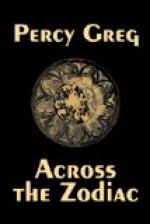On this occasion Eveena and Eunane were with me, and the astronomic pictures which were to be presented to us, and which they could enjoy and understand almost as fully as myself, sufficiently occupied our time. Warned to stand at such a distance from the central machinery that in a whole revolution no part of it could by any possibility touch us, we were placed near an opening looking into a dark chamber, with our backs to the objects of observation. In this chamber, not upon a screen but suspended in the air, presently appeared an image several thousand times larger than that of the crescent Moon as seen through a tube small enough to correct the exaggeration of visual instinct. It appeared, however, not flat, as does the Moon to the naked eye, but evidently as part of a sphere. At some distance was shown another crescent, belonging to a sphere whose diameter was a little more than one-fourth that of the former. The light reflected from their surfaces was of silver radiance, rather than the golden hue of the Moon or of Venus as seen through a small telescope. The smaller crescent I could recognise at once as belonging to our own satellite; the larger was, of course, the world I had quitted. So exactly is the clockwork or its substitute adapted to counteract both the rotation and revolution of Mars, that the two images underwent no other change of place than that caused by their own proper motion in space; a movement which, notwithstanding the immense magnifying power employed, was of course scarcely perceptible. But the rotation of the larger sphere was visible as we watched it. It so happened that the part which was at once lighted by the rays of the Sun and exposed to our observation was but little clouded. The atmosphere, of course, prevented its presenting the clear, sharply-defined outlines of lunar landscapes; but sea and land, ice and snow, were so clearly defined and easily distinguishable that my companions exclaimed with eagerness, as they observed features unmistakably resembling on the grand scale those with which they were themselves familiar. The Arctic ice was scarcely visible in the North. The vast steppes of Russia, the boundary line of the Ural mountains, the greyish-blue of the Euxine, Western Asia, Arabia, and the Red Sea joining the long water-line of the Southern Ocean, were defined by the slanting rays. The Antarctic ice-continent was almost equally clear, with its stupendous glacier masses radiating apparently from an elevated extensive land, chiefly consisting of a deeply scooped and scored plateau of rock, around the Pole itself. The terminator, or boundary between light and shade, was not, as in the Moon, pretty sharply defined, and broken only by the mountainous masses, rings, and sea-beds, if such they are, so characteristic of the latter. On the image of the Moon there intervened between bright light and utter darkness but the narrow belt to which only part of the Sun was as yet visible, and which, therefore, received comparatively few rays.




